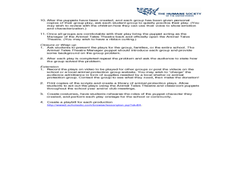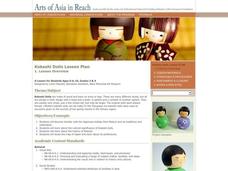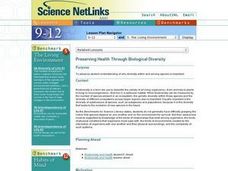Curated OER
Animal Tales Theatre
Young scholars participate in a theatre production involving how to protect animals. Students create their own puppets which will be used in the production. Young scholars read information provided to them and highlight the important...
Curated OER
"Lions and Tigers and Bears-Oh MY!"
Students explore the characteristics of an animal. What do all animals need to live and can what we expect to accomplish by studying about animals. They keep a science journal daily.
Curated OER
Creating and Destroying Symmetry
Students study the types of symmetry that appear in different basketball symbols. They point out changes that rotate symmetry from one type to another.
Curated OER
Kokeshi Dolls
Students study the Japanese holiday Hina Matsuri and its traditions and celebration. They explore the history, location and cultural significance of Kokeshi dolls.
Curated OER
PARAMILITARY VIOLENCE AND THE CONFLICT IN NORTHERN IRELAND
Young scholars examine documents to reconstruct the past, employ processes of critical historical inquiry to reconstruct the past, analyze aspects of the Northern Iereland conflict through perspectives of documents, and write a short...
Curated OER
How Do Atoms Stick Together?
In this chemical bonding learning exercise, students answer 76 questions about compounds, Lewis dot structures, intermolecular forces between atoms, electronegativity and bonding and types of bonds.
Curated OER
Periodic Table Basics Make-Up Test
In this periodic table activity, students complete a table of elements with their atomic number, atomic mass and symbol. They classify elements by their group name and distinguish between metals, nonmetals, and semi-metals. They also...
Curated OER
What do Atoms Look Like?
In this atoms worksheet, students complete 58 questions about the atomic radius of atoms, the ionization energy, the valence electrons, metals, non-metals and semi-metals and the families of elements.
Curated OER
Connection to Language Arts-Chemical Symbols
In this chemical symbols worksheet, students read about how elements were named and connect symbols to their Latin names. They answer questions about the derivatives of chemical names.
Curated OER
A Plague on Both Your Houses: a Romantic Guide To Transgression
What are the roles within your family, culture and society as well as the personal and societal consequences of transgressing them? To explore this question, class members look at long-held traditions, examples in literature...
Curated OER
Degrees and Minutes
In this latitude and longitude worksheet, middle schoolers place 9 cities on a map using the latitude and longitude of each. Once cities are placed in the correct location, students complete 2 short answer follow-up questions.
Curated OER
Art to Zoo: India-Where Remarkable Differences Are Ordinary
Students "visit" India to learn about its culture and the lives of children in India. In this India lesson, students conduct research and report on the lives of Indian children in the form of a mock interview between a journalist and an...
Curated OER
Science Hits Activity
Learners listen to a song that teaches the elements of the periodic table and write their own song to be used as an aid in remembering scientific information.
Curated OER
Preserving Health Through Biological Diversity
Students research and explore the benefits of biodiversity, particularly as it relates to human health. They write an essay in which they explain the possible effect of human activities on the emergence of new diseases.
Curated OER
Understanding Fractions
Students explore the parts of an orange to develop an understanding of the addition and subtraction of fractions. The concept of representing parts of a whole by dividing an object into smaller pieces is experienced in this hands-on...
Curated OER
DRMRS VANDERTRAMP: Le pass?? compos?? avec ??tre
Students assess the acronym DRMRSVANDERTRAMP (Dr & Mrs Van Der
Tramp) to help them memorize verbs. They pair up to create a short story describing what they did yesterday incorporating ten to fifteen of those verbs. In addition, a...
Curated OER
Where Am I: How to Read a Map
Third graders develop an understanding of maps. They explore what a map is, who uses maps, and how to use maps. Students investigate the compas rose. They create a compose rose which illustrates the cardinal directions. Students practice...
Curated OER
Hydrologic Cycle
In this science worksheet, students read about the Hydrologic Cycle. Students use the reading and a diagram to answer 2 comprehension questions.
Curated OER
The Art of Motion
In this motion worksheet, students write 2 or 3 techniques for showing motion in cartoons. Students also draw 3 cartoon panels of 2 automobiles on a highway, one moving at a constant speed and the other one accelerating.
Curated OER
Mapping Gymnosperms and Angiosperms
In this plant worksheet, students create a map of a familiar area such as their yard, a nearby park, or the school grounds showing the major plants. On their map they identify the plants in three ways following the example provided. ...
Curated OER
Formulae of Ionic Compounds
In this compounds instructional activity, students learn the steps to writing the formula for ionic compounds. This students work out the formula for 12 compounds.
Curated OER
What do Atoms Look Like?
In this atom worksheet, students complete 60 questions about the trends in atoms such as ionization energy and atomic radius, about valence electrons, about the families of elements, about metals, non-metals and semi-metals, about the...
Curated OER
Just Off Mainstreet by Elmaz Abinader
Eighth graders read writings from Elmaz Abinader. For this author analysis lesson students read an essay from Abinader and discuss the story "Just Off Mainstreet." Students re-read the text and complete close reading activities.
Curated OER
Cultural Rituals
Fifth graders explore cultural rituals. In this cultural rituals lesson, 5th graders discover different cultures way of celebrating rice. Students gain information about festivals in the US, Indonesia, Thailand, and Japan. Students...























